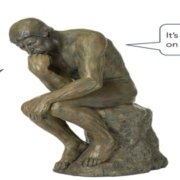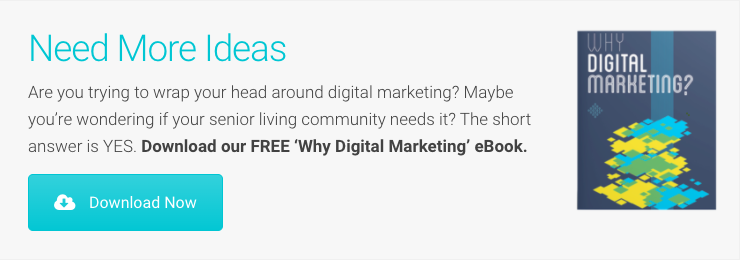How to Write a Great Senior Living Blog Post
Last week, we discussed why all senior living websites should have a blog. Now, let’s talk about the anatomy of a great senior living blog post.
1. Have a plan and a point of view for your senior living blog.
This is also known as “write regularly about compelling topics that your prospects care about.” Keep things organized and moving forward by creating an editorial calendar. It doesn’t need to be fancy, either. Add a working title (one that’s compelling and that includes a keyword phrase you’re targeting), any relevant notes, the due date, and the assigned writer.
Need ideas for topics? Turn to…
- FAQs. Think about the common questions people ask your sales team and/or the questions you get on Live Chat.
- Your competitors. Are they covering any topics you’ve overlooked? We’re not suggesting plagiarizing—the content you write should always be original—but you can certainly go to other sites for inspiration.
- Senior-focused publications. Both online and in print. Again, think inspiration.
- Your staff. And not just marketing and sales, either. Ask everyone—operations, dining, activities, and so forth—about topics they think would be important to cover. (Bonus: you might be able to use these folks as subject matter experts and/or as guest contributors.)
- Analytics. Google Analytics and Good AdWords reveal keyword phrases that are bringing people to your site. Could any of those keyword phrases become additional blog content?
- Keyword tools, such as SEMrush and BuzzSumo, can provide excellent insights—and ideas.
2. Focus on a keyword phrase (but don’t be spammy about it).
Again, always write for humans first, search engines second. You’ll find lots of advice online about where to place keyword phrases and how many times to use each phrase, but the truth is that no one knows what goes into Google’s algorithm.
Yes, it makes sense to use the keyword phrase in the title tag since that cues Google—and readers—what the blog post is about. And it makes sense to use it in your compelling headline. From there, just use the phrase—and various synonyms—naturally in your blog post.
Note: Google does tend to like an organized format, so if you can use the keyword phrase (naturally) in sub-headlines and bulleted/numbered lists, go for it.
3. Mind your grammar, spelling, and punctuation!
This matters to readers AND Google. (Google is wicked smart.) Nothing can torpedo a great topic like lousy mechanics. If the person writing the blog post isn’t a writer by trade, that’s OK—just make sure you have someone with writing/editing chops who can review the work before it goes live.
4. Watch your tone.
Your blog is a great place to be friendly and conversational. And yes, you can still be those two things while also being professional. Avoid “stiff” writing. It’s OK to use contractions, end sentences with prepositions, start sentences with “and” or “but,” and write fragments, all of which will help support a friendly, approachable, conversational style.
5. Write about those things that no one else wants to talk about.
OK, this tip isn’t for every senior living community, but if you truly want your community to stand out, then this could be a good differentiator.
Talk about hard things, but in a friendly, approachable way. Example: Tips to Prevent UTIs for Healthier Bladders.
Or how about this: Sex After 70 – It’s Good For You! You get the idea. These aren’t the sorts of topics you’ll see on many other senior living community blogs, but they ARE the types of topics that—if done right—can help your community stand out in a good way.
6. Consider hiring a professional writer.
So, here’s the thing: lots of people can write, even though they don’t wear the label “professional writer.” As long as the mechanics are sound (see point #3 above), it’s good to have a variety of voices and styles on your blog. So you might not need a professional writer, provided you have a solid marketing person who can lead the efforts and proofread/revise posts as needed.
That said, if you don’t have a person like this available on staff (and not all communities do), then yes—it does make sense to hire a professional writer. But hiring a pro doesn’t mean you should get lazy about having original content. You should make sure the writer has access to “people on the ground” (in other words, the subject matter experts in your community). Otherwise, you can expect generic content that readers can find anywhere (like “5 chair exercises for seniors”).
7. Tell people what they should do when they get to the end.
When people get to the end of the blog post, tell them what to do. This is called the call to action or CTA. It might be links to related content, an invitation to subscribe to the blog, or a download. Bottom line: Engage them further. They got to the end of your blog post, after all, so you have their attention.
You can also experiment with providing CTAs throughout the content. Just make sure these CTAs don’t distract people. You can determine this through your website and blog analytics by seeing how long people stay on the page or even if they get to the bottom of the page.
8. Measure results.
Speaking of blog analytics, you want to get a sense of topics that tend to be popular so you can develop more content like it. But you also want to pay attention to lower-performing blog posts so that you can give them some extra TLC and help them perform better.
It takes less time and money to fix/tweak existing content than it does to create new stuff, so you might as well spend the time getting ALL content to hum. Experiment with page titles, try tweaking/revising sections, re-format, add different CTAs, and so forth. If you substantially change a blog post, add a note somewhere that says “Updated on THIS DATE” and consider republishing it to gain some traction.
9. Lather, rinse, repeat (aka: do more of what works).
Blogging is a long-game. Do more of what works, tweak and improve what’s lagging, and keep an open mind when it comes to trying something new and different.
Need help with blogging?
We have writers, editors, and strategists available for short-term or longer-term contracts. Choose what works for your situation. Let’s chat about it.













